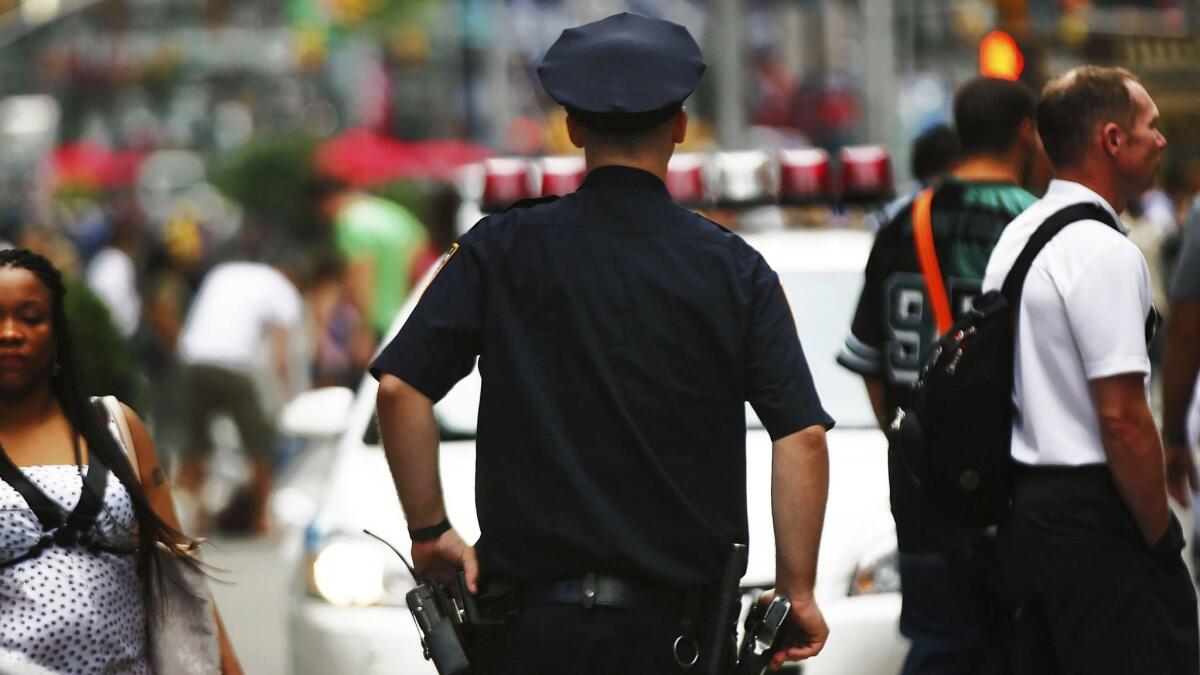What’s scarier to a New York City cop than a black man? A tall black man

- Share via
Being a tall guy is a great big asset — if you’re a tall white guy.
If you’re a tall black guy, not so much.
New research finds that the taller the African American man, the more threatening he is perceived to be — by a majority-white audience, at least.
That finding is at stark variance with a mountain of evidence that we really look up to men of physical stature. Americans tend to see taller men as more competent and intelligent. We’re more willing to hire and promote them than we are shorter men, and more likely to elect them to high office. We like them more.
But those feelings largely reflect our perceptions of white men, said Neil Hester, a social psychology graduate student at the University of North Carolina. In about 15 studies that have tested and confirmed our admiration of tall men, virtually all of the people shown to experimental subjects were white guys.
So, along with UNC psychology professor Kurt Gray, Hester tested whether the racial bias that often operates beneath our level of consciousness would change these rules when it comes to evaluating tall black men. Their hypothesis was that it would.
Hester and Gray explored a trove of existing evidence and set up online experiments in which survey-takers evaluated how much they admired or feared a collection of men who varied in height and skin color.
Their hypothesis was correct, according to a study published Monday in the Proceedings of the National Academies of Science.
The new result sheds light on such stunning findings as the one that showed we judge black men — and scary men — as taller than they really are.
Our socialized minds have given us cognitive shortcuts that equate “the other” with danger. And our most primitive instincts recognize large size as a sign of a potential adversary’s ability to subjugate us.
In other words, when we see someone as an ally, their large size comforts. When we are primed to expect confrontation, large size is a menace
For black men, Hester and Gray concluded, “height amplifies already problematic perceptions of threat, which can lead to harassment and even injury.”
That message came through when Hester and Gray combed through eight years of data generated by New York City’s controversial “stop and frisk” program.
Launched by former Mayor Michael Bloomberg, the initiative empowered New York City police officers to stop and question anyone they “reasonably suspected” of having committed a crime or who, in the view of officers, was about to commit a crime. They could frisk a person if they reasonably believed that person to be armed.
The cops’ hunches were not all that accurate. The New York Bar Assn. found that only about 6% of the stops resulted in arrests and approximately 2% in the recovery of weapons.
Other patterns emerged as well. Overall, 85% of the people stopped were black and Latino, and they were overwhelmingly male.
(In 2013, a federal district court judge ruled the stop-and-frisk program unconstitutional because it so clearly discriminated against people of color.)
In close to 1.1 million registered instances of stop and frisk, the suspicious person’s height was established by a government-issued ID. What Hester and Gray discovered about those data was striking.
Among men who stood 5 feet 4, police stopped 4.5 black men for every white man. Among men who were 5 feet 10, police stopped 5.3 black men for every white man. And among men who were a towering 6 feet 4, police stopped 6.2 black men for every white man.
Next, Hester and Gray sought to test whether experimental subjects made similar judgments.
On an online site for internet denizens willing to participate in experiments, they asked subjects to look at pictures of black men and white men who were positioned to look shorter or taller than they actually were. The subjects (the majority of them white) evaluated the men in the pictures on a number of qualities, and they took a test to gauge whether and how much they considered black people more threatening than white people.
Black men in the pictures were consistently ranked as more threatening than white men. That was especially true when the pictures made them appear taller — the black men were judged to be more menacing while the white men were judged to be more competent.
Among people who already perceived black men as threatening, the taller the black men got, the more threatening they seemed. This was true for both male and female participants, the authors found.
However, when study subjects did not reveal a fear of black people generally, they were more likely to impute greater competence to taller black men.
MORE IN SCIENCE
What the Florida school shooting reveals about the gaps in our mental health system
Ten things you should know about teen sexting
More than half of U.S. gun owners store at least one firearm without any locks, survey reveals







